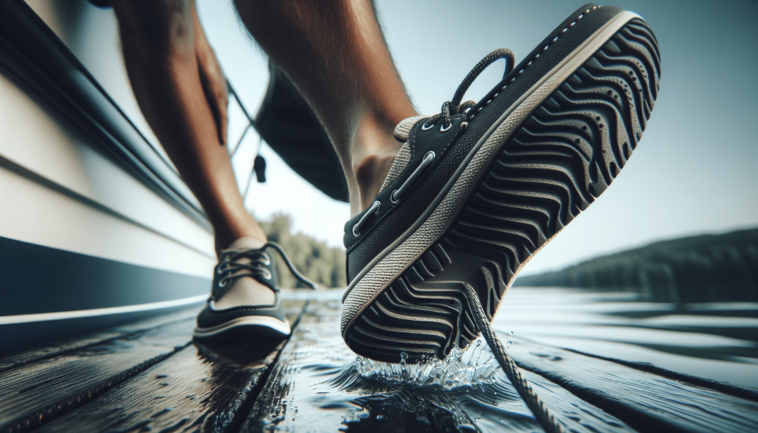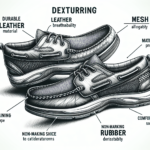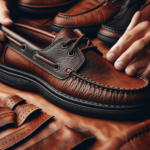In this article, we will explore the topic of men’s boating shoes and their traction capabilities. If you’ve ever wondered whether these stylish shoes could keep you steady on the slippery deck of a boat, this is the article for you. We’ll dive into the features that make these shoes suitable for boating and discuss the importance of good traction when it comes to ensuring safety and stability. So, if you’re ready to learn more about men’s boating shoes and their traction, let’s get started!
What are boating shoes?
Boating shoes, also known as deck shoes or boat shoes, are a type of footwear specifically designed for activities on or near the water. These shoes have become popular among boaters and water sports enthusiasts due to their unique features that provide excellent traction and grip on wet surfaces.
Definition of boating shoes
Boating shoes are footwear specially crafted to meet the challenges of boating activities. They are typically made with non-marking rubber soles to prevent any scuff marks on the boat deck. These shoes are characterized by their slip-resistant properties, water-resistant materials, and comfortable designs.
Features of boating shoes
Boating shoes are designed with specific features that make them ideal for boating and water-related activities. One key characteristic is their exceptional traction, which ensures stability and reduces the risk of slipping on wet surfaces. Boating shoes also often have water-resistant uppers made of materials such as leather or mesh, allowing them to withstand exposure to water while keeping the feet dry. The construction and design of these shoes prioritize durability and comfort, making them suitable for long hours spent on the deck.
Importance of traction in boating shoes
Traction is an essential factor to consider when choosing boating shoes. Proper traction is crucial to prevent accidents and ensure safety while on a boat.
Why traction is crucial in boating shoes
When on a boat, it is common for the deck to become wet due to splashing waves or rain. Without adequate traction, the risk of slipping and falling increases significantly. Boating shoes with good traction provide a reliable grip on various surfaces, including wet decks, minimizing the chances of accidents.
Dangers of inadequate traction on a boat
Inadequate traction can lead to serious injuries or even fatal accidents on a boat. A lack of grip on wet surfaces can result in slips and falls, potentially causing broken bones, head injuries, or even falling overboard. Additionally, inadequate traction can hinder the ability to navigate the boat safely and efficiently, compromising overall performance and control.
Benefits of good traction in boating shoes
Investing in boating shoes with good traction offers several advantages. Firstly, it enhances safety by providing a stable grip on wet surfaces, reducing the likelihood of accidents. Secondly, good traction allows boaters to move confidently and maintain balance, even in challenging and unpredictable conditions. Lastly, adequate traction can improve overall performance, enabling better control, agility, and maneuverability on the boat.
Factors affecting traction in men’s boating shoes
Several factors play a crucial role in determining the traction capabilities of men’s boating shoes. Understanding these factors can help you make an informed decision when choosing the right pair.
Sole material
The choice of sole material greatly influences the traction of boating shoes. Common materials used in the soles of boating shoes include rubber, siped rubber, hydro-grip, and Phylon. Rubber soles provide excellent grip and are highly durable, ideal for boating purposes. Siped soles, with their finely cut channels, offer increased flexibility and traction on wet surfaces. Hydro-Grip soles are specifically designed with enhanced grip properties to provide excellent traction. Phylon soles, made from lightweight foam material, offer adequate traction while providing cushioning and comfort.
Grip patterns
Grip patterns on the outsole are crucial in ensuring superior traction. Different patterns provide varying degrees of grip on wet surfaces. Wave grip patterns, for example, feature curved grooves that disperse water and enhance traction. Hexagonal grip patterns utilize a honeycomb-like design that improves grip and disperses water effectively. Circular grip patterns offer multidirectional traction and stability. Diamond grip patterns, with their strategically placed diamond-shaped lugs, provide reliable grip on wet surfaces.
Outsole design
The design of the outsole also affects the traction of boating shoes. Flex grooves, which are shallow channels on the outsole, allow for better flexibility and grip. Heel cup design, with its contouring around the heel, provides stability and prevents slippage. Pivot points on the outsole enhance maneuverability and agility, contributing to better traction. Lug height and spacing are also important considerations, as deeper lugs and closer spacing provide improved grip and traction on wet surfaces.
Water-resistant properties
Water-resistant properties in the upper material of boating shoes play a significant role in maintaining traction. Materials such as treated leather or water-resistant mesh prevent water absorption, keeping the shoes lightweight and maintaining their grip even in wet conditions. Having water-resistant properties ensures that the shoes retain their traction capabilities even after exposure to water, enhancing safety and performance.
Different types of sole materials used in boating shoes
The sole material used in boating shoes significantly affects their traction and performance. Understanding the different types can help you choose the right pair for your needs.
Rubber soles
Rubber soles are a popular choice for boating shoes due to their excellent traction properties. They provide reliable grip on wet surfaces and are highly durable, making them suitable for prolonged use in various conditions.
Siped soles
Siped soles feature finely cut channels known as sipes, which provide improved traction. These channels help disperse water and enhance flexibility, allowing for better grip on wet surfaces.
Hydro-Grip soles
Hydro-Grip soles are specifically designed to provide superior grip and traction. They are formulated with advanced rubber compounds and tread patterns, ensuring excellent stability even in wet conditions.
Phylon soles
Phylon soles are made from lightweight foam material, offering adequate traction while providing cushioning and comfort. Such soles are often used in boating shoes that prioritize both performance and comfort.

Common grip patterns for boating shoes
Grip patterns on the outsole are crucial in determining the traction capabilities of boating shoes. Understanding common grip patterns can help you choose the right pair suitable for your boating activities.
Wave grip pattern
The wave grip pattern features curved grooves on the outsole that disperse water and enhance traction. This pattern is effective in providing stability and grip on wet surfaces, making it ideal for boating shoes.
Hexagonal grip pattern
The hexagonal grip pattern utilizes a honeycomb-like design with interconnected hexagonal lugs. This pattern improves grip and disperses water effectively, ensuring stability and traction in various boating scenarios.
Circular grip pattern
Circular grip patterns feature concentric circular grooves that provide multidirectional traction and stability. These patterns excel in preventing slips and falls on wet surfaces, enhancing safety on the boat.
Diamond grip pattern
Diamond grip patterns consist of strategically placed diamond-shaped lugs on the outsole. This pattern offers reliable grip on wet surfaces, providing stability and traction even in challenging boating conditions.
How outsole design impacts traction
The design of the outsole plays a crucial role in determining the traction capabilities of boating shoes. Here are some aspects of outsole design that impact traction.
Flex grooves
Flex grooves are shallow channels on the outsole that enhance flexibility and grip. They allow the sole to bend and conform to various surfaces, facilitating better traction and preventing slipping.
Heel cup design
The heel cup design is crucial for stability and preventing slippage. A well-designed heel cup provides a secure fit, minimizing the risk of the foot sliding out of the shoe, and ensuring consistent traction.
Pivot points
Pivot points are specific areas on the outsole that enhance maneuverability and agility. These points allow for quick changes in direction, contributing to better traction on the boat’s deck.
Lug height and spacing
The height and spacing of lugs on the outsole impact traction. Deeper lugs provide increased grip on wet surfaces, while closer spacing between lugs offers better dispersal of water, ensuring optimal traction in different boating conditions.
Benefits of water-resistant properties
Water-resistant properties in men’s boating shoes offer several benefits beyond just ensuring dry feet. Here are some advantages of having water-resistant properties in boating shoes.
Preventing water absorption
Water-resistant materials in boating shoes prevent water from seeping into the shoe, thus keeping the shoes lightweight and comfortable. This property ensures that the traction capabilities of the shoes remain unaffected even in wet conditions.
Enhancing grip in wet conditions
Water-resistant uppers on boating shoes maintain their grip and traction even when exposed to water. By preventing water absorption, these shoes retain their ability to provide stability on wet decks, enhancing safety and minimizing the risk of slipping.
Quick-drying capabilities
Boating shoes with water-resistant properties dry quickly, allowing for greater comfort during and after water-related activities. It prevents the shoes from becoming waterlogged, ensuring optimal traction and preventing discomfort caused by soggy shoes.
Testing methods to evaluate traction in boating shoes
To ensure the reliability and performance of boating shoes, they undergo several testing methods to evaluate their traction capabilities. Here are some common testing methods used by manufacturers.
Wet surface testing
Wet surface testing evaluates the shoes’ grip when subjected to wet conditions. It involves testing the shoes on a wet surface, simulating the wet deck of a boat, and assessing their stability and traction.
Slip resistance testing
Slip resistance testing measures the shoes’ ability to prevent slips and falls on various surfaces. It assesses the shoes’ grip by subjecting them to controlled slipping scenarios, evaluating their performance and certifying their slip-resistant properties.
Oil resistance testing
Oil resistance testing evaluates the shoes’ grip when exposed to oily or greasy surfaces. This testing simulates scenarios in which the shoes encounter oil spills or surfaces coated with slippery substances, ensuring that the footwear maintains its traction.
Abrasion resistance testing
Abrasion resistance testing assesses the durability and performance of the shoes’ outsole. It measures how well the material withstands wear and tear, including the grip patterns’ ability to maintain their traction properties over time.
Recommended men’s boating shoes with excellent traction
Several brands offer men’s boating shoes that excel in traction and performance. Here are some recommended options known for their superior grip and traction capabilities.
Brand A boating shoes
Brand A is renowned for its high-quality boating shoes that prioritize traction and grip. Their shoes feature innovative outsole designs, along with water-resistant materials, to ensure maximum stability and safety on wet surfaces.
Brand B boating shoes
Brand B offers a wide range of boating shoes known for their exceptional traction and durability. Their shoes feature specially designed grip patterns and advanced sole materials that provide reliable traction in various boating conditions.
Brand C boating shoes
Brand C is recognized for its boating shoes with excellent traction properties. Their shoes are crafted with meticulous attention to detail, incorporating industry-leading outsole designs and water-resistant technologies to ensure outstanding grip on wet surfaces.
Brand D boating shoes
Brand D is a trusted name in men’s boating shoes, offering a selection of footwear that excels in traction. Their shoes combine advanced sole materials, tested grip patterns, and water-resistant properties to provide reliable traction and grip on boats.
Maintenance tips for maximizing traction in boating shoes
Proper maintenance of boating shoes is essential to maximize their traction and prolong their lifespan. Here are some maintenance tips to ensure your boating shoes retain their optimal traction capabilities.
Regular cleaning and drying
Cleaning your boating shoes after each use helps remove any dirt, salt, or debris that may affect their traction. Use a gentle brush or cloth to remove dirt and rinse with fresh water. After cleaning, allow the shoes to air dry completely to prevent any moisture that could affect their grip.
Proper storage
Storing your boating shoes correctly can help maintain their shape and traction properties. Keep them in a cool and dry place away from direct sunlight. If possible, store them with shoe trees or stuff them with newspaper to maintain their structure and prevent any deformation that may affect traction.
Inspecting and replacing worn-out soles
Regularly inspect the soles of your boating shoes for signs of wear and tear. If you notice significant wear or loss of grip patterns, it may be time to replace the soles. Worn-out soles can compromise traction and increase the risk of slipping, so timely replacements are crucial.
Applying non-slip treatments
If you want to enhance the traction of your boating shoes further, you can consider applying non-slip treatments specifically formulated for shoe soles. These treatments increase the friction between the shoe and the surface, improving grip and reducing the risk of slipping on wet decks.
By following these maintenance tips, you can ensure that your boating shoes retain their optimal traction capabilities and provide you with maximum safety and performance on the water.







